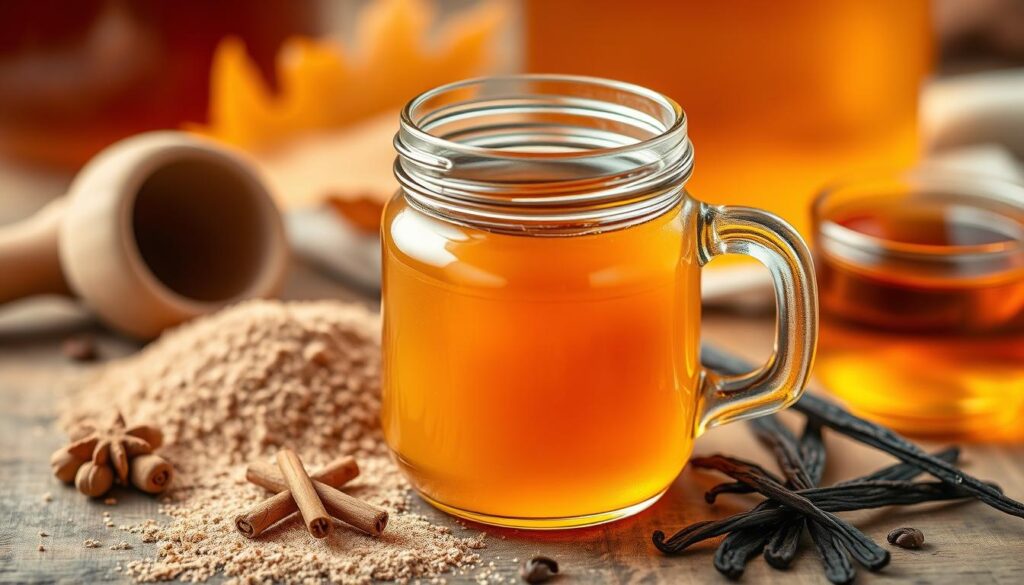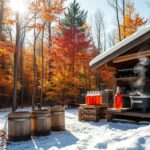Maple syrup is more than just sugar. It’s a natural sweetener with a complex story. When you learn what maple syrup is made of, you find a mix of chemical compounds and nutrients. This makes it truly special.
Sugarmakers collect maple syrup from trees in the forest. They turn raw sap into a tasty condiment. Unlike other sweeteners, maple syrup has natural ingredients that give it a unique taste and health benefits.
Maple syrup is not just sweet. It also has minerals, antioxidants, and complex sugars. Each drop is a mix of water, sucrose, glucose, and many micronutrients. This blend adds flavor and health benefits.
Maple trees are tapped during certain seasons to get sap. The syrup’s ingredients reflect the tree’s environment and harvest time. Each region, like Vermont and Quebec, adds its own touch to the syrup.
The making of maple syrup is a natural process. Sap, with little sugar, is boiled to become the syrup we love. This shows how nature and human skill work together.
Understanding the Natural Composition of Pure Maple Syrup
Pure maple syrup is a unique natural sweetener. It’s different from other sugars because it’s made from maple tree sap. This process gives it a special flavor and nutritional value.
The journey of maple syrup from tree to table is fascinating. It’s not just sugar. It’s a mix of compounds that make it taste great and offer health benefits.
Primary Chemical Components
Pure maple syrup has a complex mix of chemicals:
- Water (about 33%)
- Sucrose (main sugar)
- Organic acids
- Nitrogen compounds
- Phenolic substances
Natural Sugar Compounds
Maple syrup has a variety of natural sugars:
| Sugar Type | Percentage | Characteristics |
|---|---|---|
| Sucrose | 60-67% | Primary sugar compound |
| Glucose | 1-4% | Simple sugar |
| Fructose | 1-4% | Fruit sugar |
Mineral Content Overview
Maple syrup is full of minerals. Trace minerals like zinc, manganese, calcium, and potassium are in it. These minerals add to its nutritional value, not just sweetness.
“Pure maple syrup is nature’s liquid gold, a testament to the complexity of natural sweeteners.” – Maple Syrup Research Institute
Knowing how maple syrup is made shows why it’s better than refined sugars. Its complex structure gives it great taste and health benefits.
What is Maple Syrup Made Of?
Maple syrup is a natural sweetener made from Maple Tree Sap. It’s collected in late winter and early spring. This liquid gold starts as clear water in maple trees and changes a lot.
The main parts of maple syrup are simple. It’s made of:
- Raw maple tree sap – the main ingredient
- Natural sugars made by boiling
- Trace minerals from the tree
- Water that gets less during processing
To make maple syrup, sugarmakers collect sap from maple trees. They tap the trees when it’s cold at night and warm during the day. This makes the sap flow. The sap has about 2% sugar and is boiled down to make the syrup we know.
“Maple syrup is nature’s purest sweetener, created through a delicate dance between temperature, tree, and time.” – Traditional Sugarmaker’s Wisdom
Boiling the sap is key. It takes about 40 gallons of sap to make one gallon of syrup. This shows how intense making maple syrup is.
Every drop of maple syrup is a mix of natural sugars, minerals, and flavors. These can’t be made artificially.
The Journey From Tree to Table: Maple Sap Collection
Maple syrup starts with collecting sap from maple trees. The process picks the right trees at the best times of the year. It’s a careful craft that depends on the health of the trees and how much sap they produce.
Collecting maple sap is a precise task. Skilled producers must pay close attention to many important details.
Optimal Tapping Conditions
Collecting maple sap needs the right weather. Temperature is key in the process:
- Daytime temperatures between 40-45°F
- Nighttime temperatures below freezing (around 20-25°F)
- Clear, sunny days with cold nights
Traditional vs Modern Collection Methods
Maple syrup makers have changed their ways over time:
| Method | Characteristics | Efficiency |
|---|---|---|
| Traditional Bucket Method | Hand-collected sap in wooden buckets | Low-volume, labor-intensive |
| Modern Tubing System | Vacuum-assisted pipeline network | High-volume, efficient collection |
Seasonal Impact on Sap Quality
The season affects sap quality a lot. Early spring is the best time to harvest, lasting about 4-6 weeks. Each tree can give 10-20 gallons of sap, which turns into just one quart of syrup.
Knowing how sap is collected helps us see the amazing journey from tree to table.
The Science Behind Maple Tree Sap Production
Maple tree sap production is a fascinating natural process. It turns simple tree biology into a delicious sweetener. To understand how maple syrup is made, we must explore the unique ways maple trees work.
Trees produce sap as a survival mechanism during seasonal changes. In winter, maple trees store starches in their roots and trunk. When temperatures start to change, these starches turn into sugar. This sugar-rich liquid is the main ingredient for maple syrup.
- Maple trees generate sap through complex internal pressure systems
- Temperature variations trigger sap movement within tree tissues
- Seasonal shifts play a critical role in maple tree sap generation
The science behind maple tree sap production relies on several environmental factors:
- Temperature Fluctuations: Alternating freezing and thawing creates pressure changes
- Tree Physiology: Specialized cells transport nutrients and water
- Seasonal Timing: Typically occurs during late winter and early spring
Sugarmakers know that making maple syrup well requires precise timing and knowledge of tree biology. The dance between temperature, tree physiology, and environmental conditions is key. It creates the perfect conditions for extracting maple tree sap.
Essential Minerals and Nutrients in Natural Maple Syrup
Pure maple syrup is more than a sweetener. It’s packed with minerals and nutrients that are good for you. Its rich nutritional profile makes it stand out from other sweeteners.
The ingredients in maple syrup are full of essential nutrients. Sugarmakers work hard to keep these minerals in the syrup. This way, they make sure it stays rich and healthy.
Trace Elements Present
Maple syrup is full of trace minerals that are good for your health:
- Manganese: Supports bone health and metabolism
- Zinc: Boosts immune system function
- Calcium: Promotes strong bones and teeth
- Potassium: Supports heart and muscle function
- Magnesium: Aids in energy production
Health-Beneficial Compounds
Studies show that pure maple syrup has special compounds that are good for you. These natural elements make maple syrup different from processed sweeteners.
| Compound | Potential Health Benefit |
|---|---|
| Quebecol | Anti-inflammatory properties |
| Polyphenols | Supports cellular protection |
| Phenolic Compounds | Antioxidant protection |
Antioxidant Properties
“Maple syrup has more antioxidants than many other natural sweeteners, making it a healthier choice,” says Dr. Helen Richardson.
The antioxidants in maple syrup help fight oxidative stress. These compounds may help reduce cell damage and improve overall health.
Sugarmakers know how to collect and process maple sap to keep its nutrients. This makes pure maple syrup a special and healthy natural sweetener.
The Complex Sugar Profile of Maple Syrup
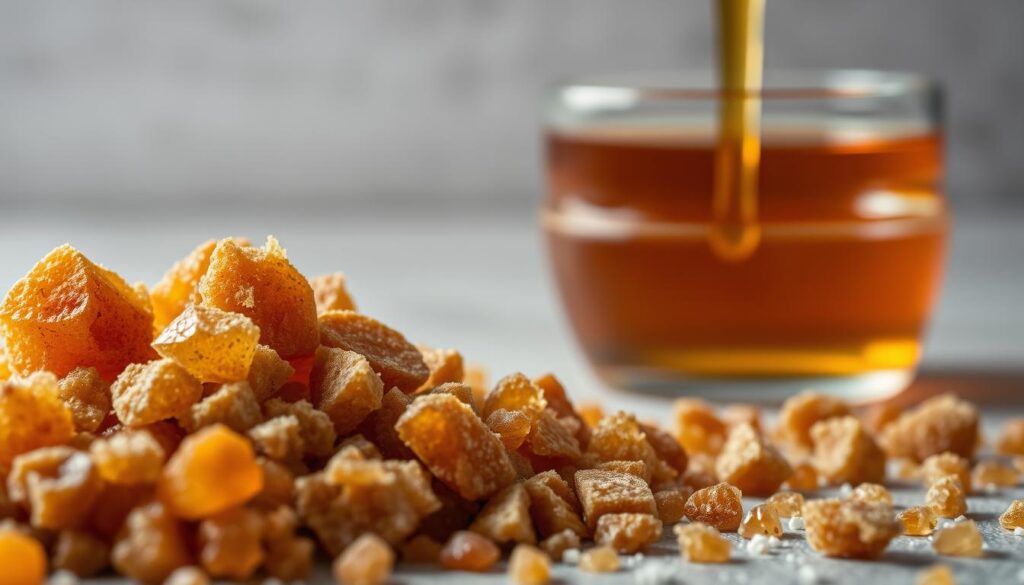
Maple syrup is a unique sweetener with a complex sugar profile. This makes it different from other natural sweeteners. The sugar composition is key to its distinct flavor and nutritional benefits.
The main sugars in maple syrup are:
- Sucrose: Makes up about 60-70% of the syrup’s sugar
- Glucose and fructose: These sugars add to the syrup’s profile
- Complex oligosaccharides: These complex sugars enhance the syrup’s molecular structure
Maple Syrup Ingredients show a natural sugar complexity. The sugar content changes based on tree species, tapping season, and location. Sugarmakers watch these factors to get the best flavor and quality.
The unique sugar profile gives maple syrup its special traits:
- It’s sweeter than refined sugars
- It has a lower glycemic index than other sweeteners
- It has a rich, complex flavor
Maple syrup is more than a sweetener. It’s a complex natural product with deep flavor and nutritional value.
Analyzing the Water Content and Concentration Levels
The Maple Syrup Production process depends on accurate water content and concentration. Sugarmakers watch these closely to make sure top-quality maple syrup gets to people.
Understanding maple syrup concentration involves several important factors. These factors affect the syrup’s quality and consistency. Professionals use special methods to check the syrup’s quality.
Brix Measurement Standards
Brix measurement is key for checking sugar levels in maple syrup. This method helps producers check the syrup’s quality by measuring sugar content:
- Standard Brix range for maple syrup: 66-67 degrees
- Measurement done with special refractometers
- Shows sugar density and syrup quality
Density Requirements
Density is very important in maple syrup making. Sugarmakers need to keep certain density levels for the right syrup consistency:
- Ideal density: 11.5 pounds per gallon
- Water content must stay below 33%
- Keeping the right temperature during evaporation
Professional sugarmakers use advanced techniques to ensure each batch meets these strict standards. This guarantees a premium maple syrup experience for everyone.
Natural Flavor Compounds That Define Maple Syrup
The unique taste of real maple syrup comes from a mix of natural compounds. These compounds form during the syrup-making process. They turn simple maple sap into a rich, complex culinary delight.
Maple Syrup Ingredients create a unique taste through several key compounds:
- Furanones: Sweet, caramel-like molecules that form when heated
- Phenolic compounds: Add subtle woody and smoky notes
- Amino acids: Create deep, complex flavors during heating
Sugarmakers watch over the transformation of these compounds closely. The right mix of heat, time, and sap quality shapes the syrup’s flavor. Different maple trees and places can also change the taste a bit.
Studies have found over 300 unique flavor compounds in maple syrup. It’s one of the most complex natural sweeteners. Each drop has a special mix of tastes that show the tree’s surroundings and the maple-making skill.
“Maple syrup is nature’s most complex flavor symphony” – Maple Science Institute
Processing Methods and Their Impact on Ingredients
Maple syrup production is a detailed process. It turns raw maple sap into the tasty golden liquid we love. The journey of making Maple Syrup requires precision and attention, mainly in evaporation and temperature control.
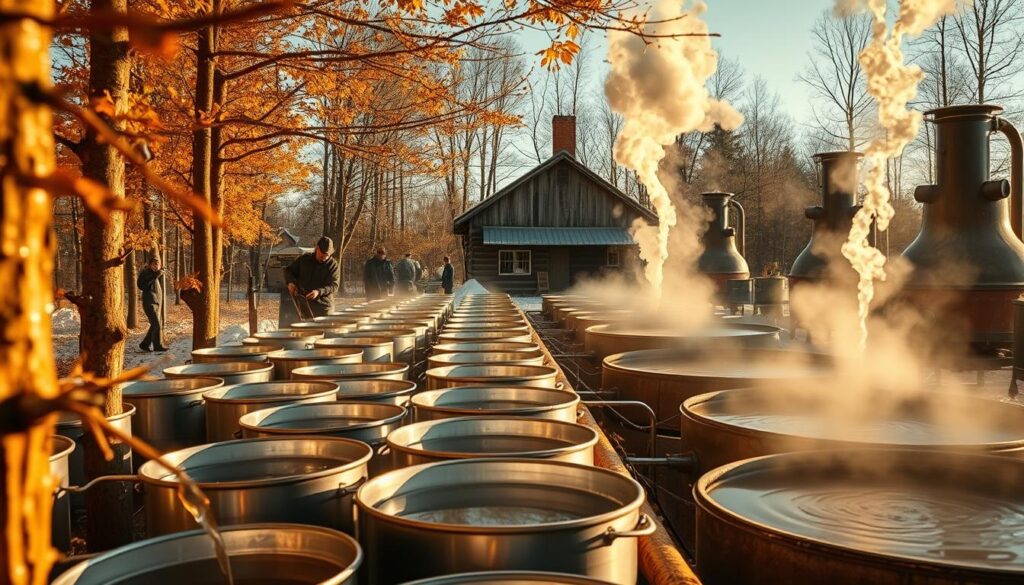
The art of making Maple Syrup starts with knowing the key processing methods. These methods define its quality and flavor. Sugarmakers use special techniques to make sure the syrup tastes great and is consistent.
Evaporation Techniques
Evaporation is the most important step in making maple syrup. Sugarmakers use two main methods:
- Traditional Wood-Fired Evaporators: Give a rich, smoky taste
- Modern Reverse Osmosis Systems: Make the process faster and more efficient
Temperature Control Effects
Temperature is key in shaping the syrup’s final traits. Keeping the heat just right ensures:
- The right sugar level
- Keeping natural flavors intact
- Consistent texture and color
Experts keep the temperature between 104°C and 107°C at the end. This careful heat control stops burning and keeps the syrup’s flavor delicate.
Grading Systems and Color Classifications
Knowing how to grade Authentic Maple Syrup helps you choose the right flavor and quality. Sugarmakers follow a set method to show the syrup’s color, taste, and when it was made.
The USDA has four main grades of Pure Maple Syrup:
- Golden Color, Delicate Taste: Lightest grade, harvested early in the season
- Amber Color, Rich Taste: Medium amber shade with stronger maple flavor
- Dark Color, Robust Taste: Deep amber with intense maple characteristics
- Very Dark Color, Strong Taste: Darkest grade with most pronounced flavor
As the maple season goes on, the syrup colors change. Sap from early spring makes lighter syrups. Later sap makes darker syrups with deeper flavors.
Sugarmakers watch the color closely to meet quality standards. This system helps you pick syrup that tastes good to you.
“The color tells a story of the syrup’s journey from tree to table” – Maple Syrup Producers Association
Preservation Methods and Natural Shelf Life
Pure Maple Syrup needs careful preservation to keep its quality and taste. The Maple Syrup Process uses special storage methods. These methods help keep the syrup fresh for a long time and stop it from getting worse.
Storing maple syrup right is key to keeping it good. Unlike many foods, maple syrup stays fresh for a long time if stored properly.
Essential Storage Requirements
- Store in a cool, dark place
- Use tight containers to stop contamination
- Keep it away from sunlight and heat
- Put it in the fridge after opening to keep it fresh longer
Preventing Crystallization
Crystallization is a natural thing that happens in maple syrup. But, there are ways to stop it or fix it. Sugarmakers suggest a few methods to keep the syrup smooth:
- Warm up crystallized syrup slowly to make it liquid again
- Don’t let the temperature change too much
- Keep it at a steady temperature between 40-45°F
Tip: Unopened maple syrup can last up to a year if stored right. But, opened syrup should be used within six months for the best taste.
Good storage keeps maple syrup’s natural flavor and taste. This lets fans enjoy its rich, real taste.
Understanding Maple Syrup Additives and Preservatives
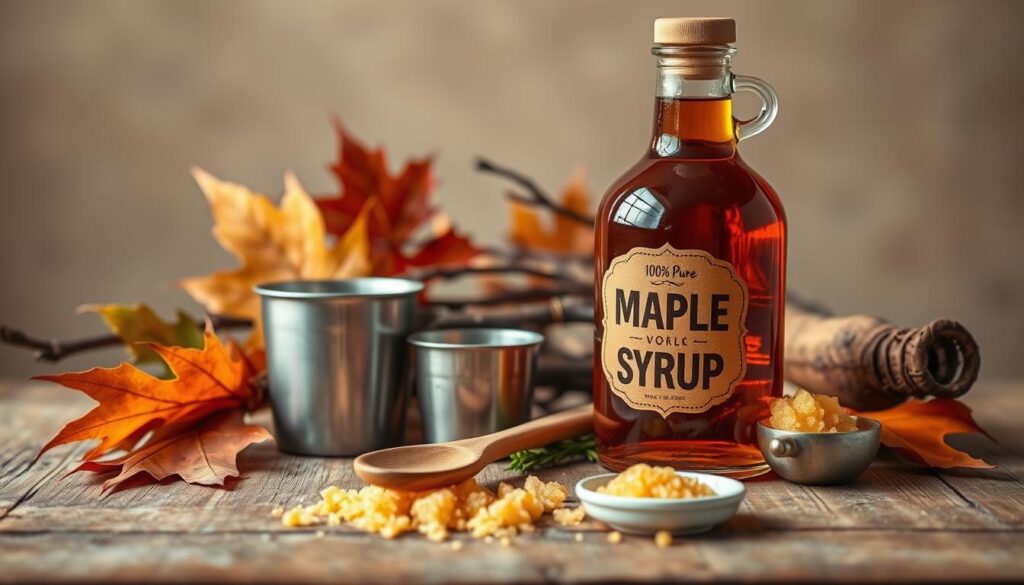
Pure maple syrup is a natural food, needing no extra preservatives or artificial stuff. It’s made by taking the sap from maple trees and concentrating it. This process is simple and focuses on the natural sap.
Real maple syrup is mostly just sap from maple trees. This sap is boiled down to make the syrup we love. It’s a simple, natural process.
- Authentic Maple Syrup contains no artificial preservatives
- Natural filtering and boiling process ensures product stability
- Minimal processing maintains nutritional integrity
But, commercial maple syrups are different. They often have extra stuff to make them taste better, last longer, and cost less.
| Ingredient Category | Pure Maple Syrup | Commercial Syrup |
|---|---|---|
| Primary Ingredient | 100% Maple Sap | Corn Syrup, Flavorings |
| Preservatives | None | Potassium Sorbate, Sodium Benzoate |
| Sugar Content | Natural Maple Sugars | Added Refined Sugars |
Sugarmakers know that maple syrup’s natural sugar helps keep it fresh. The syrup’s sugar and careful making stop bacteria from growing.
“Pure maple syrup is nature’s perfect sweetener, requiring nothing extra to maintain its incredible flavor and quality.” – Maple Syrup Production Expert
If you want real maple syrup, look for products labeled 100% pure. This way, you get syrup without extra additives.
Comparing Pure vs Artificial Maple Syrup Components
Not all maple syrups are the same. People looking for sweet toppings often find big differences between real maple syrup and fake ones.
Pure maple syrup is a natural product with little processing. It’s made from just concentrated maple sap from maple trees.
Commercial Syrup Ingredients: What’s Really in Your Bottle?
Artificial maple syrups have many ingredients that are far from real:
- High fructose corn syrup
- Chemical flavor enhancers
- Artificial caramel coloring
- Preservatives
Identifying Authentic Products
Finding real maple syrup means reading labels carefully and knowing what to look for:
| Authentic Marker | What to Look For |
|---|---|
| Ingredient List | Single ingredient: Maple Syrup |
| Grade Certification | USDA Grade A or B |
| Price Point | Higher cost reflects natural production |
*”Real maple syrup is nature’s liquid gold – pure, unprocessed, and incredibly nuanced.”*
Sugarmakers are proud of making real Pure Maple Syrup. They keep traditional ingredients and high quality standards.
Regional Variations in Maple Syrup Composition
Maple Syrup Production shows interesting differences based on where it’s made. Different areas in North America give maple syrup its own special taste and makeup. This makes each syrup unique and authentic.
The minerals and flavor of maple syrup can change a lot based on where it’s made. For example, Vermont, Quebec, and New York each make syrups that are special because of their local forests.
- Northeast regions typically create lighter, more delicate maple syrups
- Midwest maple production generates deeper, more robust flavor profiles
- Canadian provinces often yield syrups with higher mineral concentrations
Soil and the environment around maple trees are key to syrup’s flavor. Microclimatic conditions like temperature, rain, and forest density affect tree health and sap quality.
Maple syrup from different places is incredibly diverse. The environment around maple trees adds special flavors that fans love and cherish.
“Each drop of maple syrup tells a unique story of its geographic origin” – Maple Syrup Artisans Association
Conclusion
Exploring what maple syrup is made of is a fascinating journey. It starts in the forest and ends on our tables. Pure maple syrup shows nature’s amazing ability to make complex, tasty sweeteners.
The process of turning maple tree sap into syrup is a mix of science, tradition, and nature. It’s a delicate balance that creates a rich, golden liquid.
Every drop of pure maple syrup is special. It has unique minerals, sugars, and flavors that artificial sweeteners can’t match. Sugarmakers in North America work hard to make this natural treasure. They use old techniques and new science to create a sweetener that’s full of nutrients.
Maple syrup is more than just a sweetener. It’s a blend of culinary art and natural science. Its minerals and sugar profile make it a special treat. It’s a celebration of sustainable food and the magic of maple trees.
Appreciating maple syrup means seeing the beauty in its complexity. It’s a reminder that the best culinary experiences come from simple, natural ingredients.

